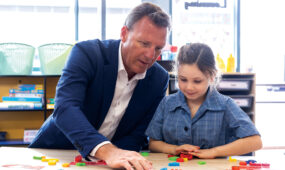What does artificial intelligence mean for teachers and students?
Schools
It’s no surprise that the meteoric rise in AI (Artificial Intelligence) has been a hot topic of conversation among teachers and education in general across 2023, let alone in most industries.

AI has quietly been part of our lives for years; think virtual assistants, predictive smart phone features, surveillance and the like. It simply can’t be ignored as it weaves its way into the fabric of our culture.
Put your hand up if you’re a teacher who used ChatGPT to help write your mid-year student reports?
It stands to reason that embracing AI in our schools is only going to better equip young people in the ever-changing years ahead and, to boot, South Australia is leading the country as the only state having chosen to accommodate AI in schools.
Advertisement
Like it or not, AI is now a part of our world – a world that everyone, including students will continue to be a part of.
What exactly can AI do? How can it help me and my teaching? How can I embrace this technology? These are questions that can struggle to allay fears like: How will this impact my job? Am I going to have to learn something new? How do I keep ahead of my students?
These are all real questions, and while the AI dust is still floating in air, a little more time is needed to see how it settles on the floor.
So, for most of us, ChatGPT (Generative Pre-Trained Trans-former) has been the general go-to for those wanting to dip their toes in the AI space. If you haven’t already satisfied your curiosity, chat.openai.com is your starting point.
AI in education can be likened to paradigm shifts like access to the internet in the late 1990s and creative mobile devices incorporating built-in cameras in the early 2010s. And as AI seamlessly integrates into our lives more and more, as educators we must ask ‘What does this mean for the future of student learning, your teaching and importantly, student assessment?’.
What will we be assessing? When AI creates the written content you couldn’t write, the complex code you didn’t understand, and the images you couldn’t take, how do we shift our quality teaching and learning to cater for this? AI interprets inputs, generates new content and presents solutions one may not have thought of previously.
Take ‘twee.com’ for example. Built for teachers and currently free to use. You have found a fantastic YouTube video that suits your teaching perfectly. With a YouTube link and a few keystrokes, Twee will analyse the video and generate a series of review questions – in a format of your choice, for students to answer.
If you haven’t yet seen how ‘Generative Fill’ can be used in Photoshop, it is worth a search. Amazingly scary.
And for a bit of fun, how Arnold Schwarzenegger’s face and voice have become a viral meme – applied to well-known and loved music (think The Sound of Music, The Wizard of Oz, Michael Jackson).
But for learners, where does the line between creativity and AI generation become blurred?
Advertisement
For example, Generative AI tools use what they can to determine an answer. One might say they ‘hallucinate’ by creating a false sense of truth. Instead of us as humans who simply say, ‘I don’t know’.
As the AI juggernaut advances at break-neck speed, educators may need to be open to this new paradigm shift. To find, adapt and explore new and inventive ways for AI to expand their teaching, simplify processes, support students and be a technology not to weaken creativity but to allow opportunities for more.
Matt Richards: Creative Digital Learning






